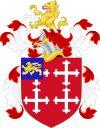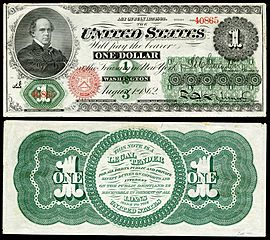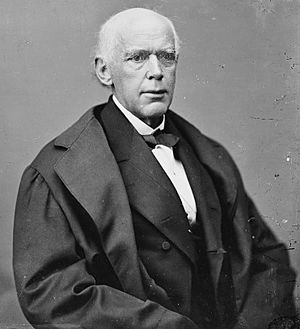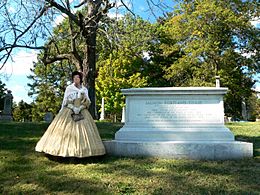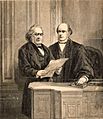Salmon P. Chase facts for kids
Quick facts for kids
Salmon P. Chase
|
|
|---|---|
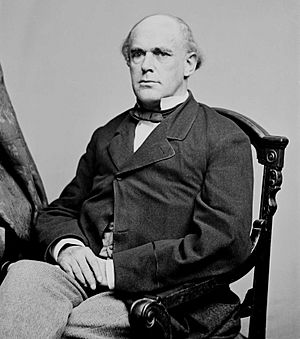
Portrait by Mathew Brady, c. 1860–1865
|
|
| 6th Chief Justice of the United States | |
| In office December 15, 1864 – May 7, 1873 |
|
| Nominated by | Abraham Lincoln |
| Preceded by | Roger B. Taney |
| Succeeded by | Morrison Waite |
| 25th United States Secretary of the Treasury | |
| In office March 7, 1861 – June 30, 1864 |
|
| President | Abraham Lincoln |
| Preceded by | John Adams Dix |
| Succeeded by | William P. Fessenden |
| United States Senator from Ohio |
|
| In office March 4, 1849 – March 3, 1855 |
|
| Preceded by | William Allen |
| Succeeded by | George Pugh |
| In office March 4, 1861 – March 6, 1861 |
|
| Preceded by | George Pugh |
| Succeeded by | John Sherman |
| 23rd Governor of Ohio | |
| In office January 14, 1856 – January 9, 1860 |
|
| Lieutenant |
|
| Preceded by | William Medill |
| Succeeded by | William Dennison |
| Personal details | |
| Born |
Salmon Portland Chase
January 13, 1808 Cornish, New Hampshire, U.S. |
| Died | May 7, 1873 (aged 65) New York City, U.S. |
| Resting place | Spring Grove Cemetery |
| Political party |
|
| Spouses |
|
| Children | 2, including Kate |
| Relatives | Chase family |
| Education | Dartmouth College (BA) |
| Signature | |
Salmon Portland Chase (born January 13, 1808 – died May 7, 1873) was an important American politician and judge. He served as the sixth Chief Justice of the United States. He was also the 23rd Governor of Ohio, a U.S. Senator for Ohio, and the 25th Secretary of the Treasury. This means Chase was one of the few American leaders to work in all three parts of the federal government: the judicial, executive, and legislative branches.
Chase was born in Cornish, New Hampshire. He studied law and became a lawyer in Cincinnati. He was a strong opponent of slavery. He often defended enslaved people who had escaped and those who helped them. Chase helped start the Liberty Party and later the Free Soil Party. These parties worked to stop slavery from spreading.
He was elected to the Senate in 1849. He spoke out against laws that supported slavery, like the Compromise of 1850 and the Kansas–Nebraska Act. After the Kansas-Nebraska Act, Chase helped create the Republican Party. This new party was against slavery expanding into new areas. From 1856 to 1860, he served as the Governor of Ohio.
In 1860, Chase wanted to be president, but the Republican Party chose Abraham Lincoln. After Lincoln won, he asked Chase to be his Secretary of the Treasury. Chase worked hard to make sure the Union had enough money during the Civil War. In 1864, Lincoln made Chase the Chief Justice of the Supreme Court.
As Chief Justice, Chase led the Supreme Court from 1864 until his death in 1873. He oversaw the trial of President Andrew Johnson when Johnson was almost removed from office in 1868. Even while on the Supreme Court, Chase still hoped to become president. He tried to get the nomination from the Democratic Party in 1868 and the Liberal Republican Party in 1872, but he was not successful.
Contents
Early Life and Education
Salmon Chase was born in Cornish, New Hampshire, on January 13, 1808. His parents were Janette Ralston and Ithamar Chase. His father died in 1817 when Salmon was nine years old. His mother was left with ten children and not much money.
From 1820 to 1824, Salmon lived in Ohio with his uncle, Bishop Philander Chase. His uncle was an important leader in the Episcopal Church in the western United States. Another uncle was U.S. Senator Dudley Chase from Vermont.
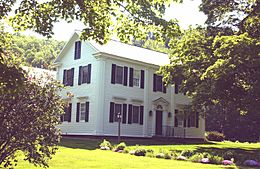
Chase went to schools in Windsor, Vermont, and Worthington, Ohio. He also studied at Cincinnati College. Later, he joined Dartmouth College as a junior. He was a member of the Alpha Delta Phi and Phi Beta Kappa groups. He graduated from Dartmouth with honors in 1826. While at Dartmouth, he taught at the Royalton Academy in Royalton, Vermont.
After college, Chase moved to Washington, D.C.. He started a school there while studying law. He learned law from U.S. Attorney General William Wirt. Chase became a lawyer in 1829.
The house where Salmon P. Chase was born and grew up is still standing in Cornish, New Hampshire. It is now a National Historic Landmark.
Fighting Against Slavery
Chase moved to Cincinnati, Ohio, in 1830 and started practicing law. He became well-known for writing a detailed collection of Ohio's laws.
Even though it could hurt his career, Chase often defended people who had escaped slavery. He also defended those who were accused of helping them. One famous case was the Matilda Case in 1837. Chase became very dedicated to ending slavery. He was influenced by events in Cincinnati, like an attack on an anti-slavery newspaper.
Chase was called the "Attorney General for Fugitive Slaves." This was because he defended people arrested under the Fugitive Slave Act of 1793. He argued that slavery should only exist where state laws allowed it. He believed that the federal government could not create slavery. He also argued that if an enslaved person left a state where slavery was legal, they were no longer enslaved. The courts, however, usually disagreed with him.
Chase was first elected to the Cincinnati City Council as a Whig in 1840. But he left the Whig Party the next year. In the 1840s, he helped form the Liberty Party. For seven years, Chase was a leader of this party in Ohio. He helped write the national Liberty platform in 1843.
By 1848, Chase led efforts to combine the Liberty Party with other groups to form the Free Soil Party. He wrote the Free-Soil platform. He also helped convince former President Martin Van Buren to run for president as their candidate in 1848.
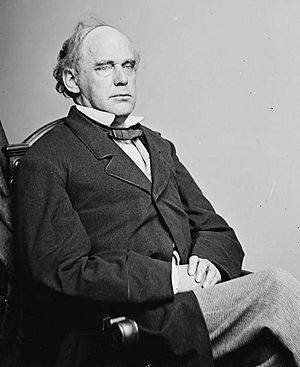
In 1849, Chase was elected to the United States Senate from Ohio as a Free Soiler. His main goal was to pressure Northern Democrats to oppose the spread of slavery. During his time with the Liberty and Free Soil parties, Chase called himself an "Independent Democrat."
While in the Senate (1849–1855), Chase was a strong voice against slavery. He spoke out against the Compromise of 1850 and the Kansas–Nebraska Act of 1854. After the Kansas-Nebraska Act led to violence, Chase helped create the Republican Party. This party included former Whigs and other anti-slavery groups. Chase helped write an important document called the "Appeal of the Independent Democrats." This document is seen as an early statement of the Republican Party's beliefs.
In 1855, Chase became the first Republican governor of Ohio. He served from 1856 to 1860. As governor, he supported better property rights for women. He also worked to improve public education and prison reform.
In 1860, Chase wanted to be the Republican candidate for president. He was one of the most famous Republicans working to end slavery. However, he did not support a "protective tariff," which many other Republicans liked. Also, his past work with Democrats bothered some Republicans. At the 1860 Republican National Convention, he did not get enough support. Abraham Lincoln won the nomination, and Chase supported him.
Chase was elected to the U.S. Senate again in 1860. But he resigned soon after to become Secretary of the Treasury for President Lincoln. He also attended a peace meeting in Washington, D.C., in February 1861. This meeting tried to stop the country from splitting apart before the Civil War.
Helping the Union During the Civil War
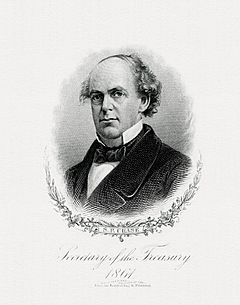
During the Civil War, Chase was the Secretary of the Treasury in President Lincoln's cabinet from 1861 to 1864. This was a very difficult time for the country's money. Chase made two big changes to American financial policy. He created a national banking system and started printing paper money.
The national banking system was Chase's idea. He planned how it would work and convinced Congress to approve it. This system helped the government sell bonds to pay for the war. It also created a stable national currency that was the same everywhere. Chase worked with a company called Jay Cooke & Company to sell $500 million in government war bonds in 1862.
The first U.S. federal paper money, called "greenbacks," was printed in 1861–1862. Chase was responsible for designing these notes. To make himself more well-known, Chase put his own face on some of the U.S. paper money, starting with the $1 bill.
In May 1862, Chase went with President Lincoln and other leaders to Fort Monroe. They wanted to see if they could capture Norfolk. Chase helped inspect landing spots for troops. His involvement ended with Norfolk's surrender and the destruction of the Confederate ship, the CSS Virginia.
Chase wanted to be president again in 1864. He used his position as Treasury Secretary to gain political support. He also often threatened to resign, knowing it would cause problems for Lincoln.

To honor Chase for his work with banknotes, his picture was put on the $10,000 bill. This was the largest U.S. currency bill that was used by the public. Chase also helped put the phrase "In God We Trust" on United States coins in 1864.
Leading the Supreme Court
In June 1864, Lincoln accepted Chase's resignation as Treasury Secretary. Lincoln no longer needed Chase in his cabinet to prevent him from running for president. But to keep a group called the Radical Republicans happy, Lincoln thought about nominating Chase for the Supreme Court.
When Chief Justice Roger B. Taney died in October 1864, Lincoln chose Chase to take his place. Chase was nominated on December 6, 1864, and confirmed by the U.S. Senate on the same day. He became Chief Justice on December 15, 1864, and served until his death in 1873. One of his first actions was to allow John Rock, an African-American attorney, to argue cases before the Supreme Court.
Some of his important decisions on the Court included:
- Texas v. White (1869): He said that the Constitution created a lasting union of states that could not be easily broken.
- Veazie Bank v. Fenno (1869): This decision supported a Civil War law that taxed state banknotes.
- Hepburn v. Griswold (1870): This ruling said that some parts of the legal tender laws (about paper money) were against the Constitution. Later, this decision was changed after new judges joined the court.
As Chief Justice, Chase also led the impeachment trial of U.S. President Andrew Johnson in 1868. Even though he was a judge, Chase still wanted to be president. He tried to get the Democratic nomination in 1868. He was not chosen because he supported voting rights for black men. In 1872, he helped start the Liberal Republican Party but did not get their presidential nomination either.
A few months before he died, Chase was part of a 5-4 ruling in the Slaughter-House Cases. This decision limited the power of the federal government to protect people's civil rights under the Fourteenth Amendment. Chase disagreed with the majority, saying their decision made the Fourteenth Amendment almost useless.
Death and Legacy
Salmon Chase died from a stroke in New York City on May 7, 1873. He was first buried in Oak Hill Cemetery in Washington, D.C.. Later, in October 1886, his remains were moved to Spring Grove Cemetery in Cincinnati, Ohio.
After Chase's death, the Supreme Court started a tradition. When a Justice dies, their chair and the front of the bench where they sat are covered with black cloth. Black cloth is also hung over the Court's entrance.
The Chase National Bank, which is now part of JPMorgan Chase, was named in his honor. However, he had no direct connection to the bank.
In 1845, black leaders in Cincinnati gave Chase a silver pitcher. It had words engraved on it thanking him for his help to "the oppressed."
Chase's picture appears on the United States $10,000 bill. This was the largest amount of U.S. money that was used by the public. The last $10,000 bill was printed in 1945.
Several places are named after him, including Chase County, Kansas, and Chase City, Virginia. Towns named "Chaseville" in different states also honor him. Camp Chase in Columbus, Ohio, and Chase Hall at the United States Coast Guard Academy are named for his service as Secretary of the Treasury. The U.S. Coast Guard cutter Chase (WHEC 718) is also named after him. Other places include Chase Hall at Harvard Business School and the Salmon P. Chase College of Law at Northern Kentucky University.
Images for kids
-
Associate Justice of the Supreme Court Samuel Nelson (left) gives the oath to Chief Justice Chase during the impeachment trial of Andrew Johnson.
See also
 In Spanish: Salmon P. Chase para niños
In Spanish: Salmon P. Chase para niños


